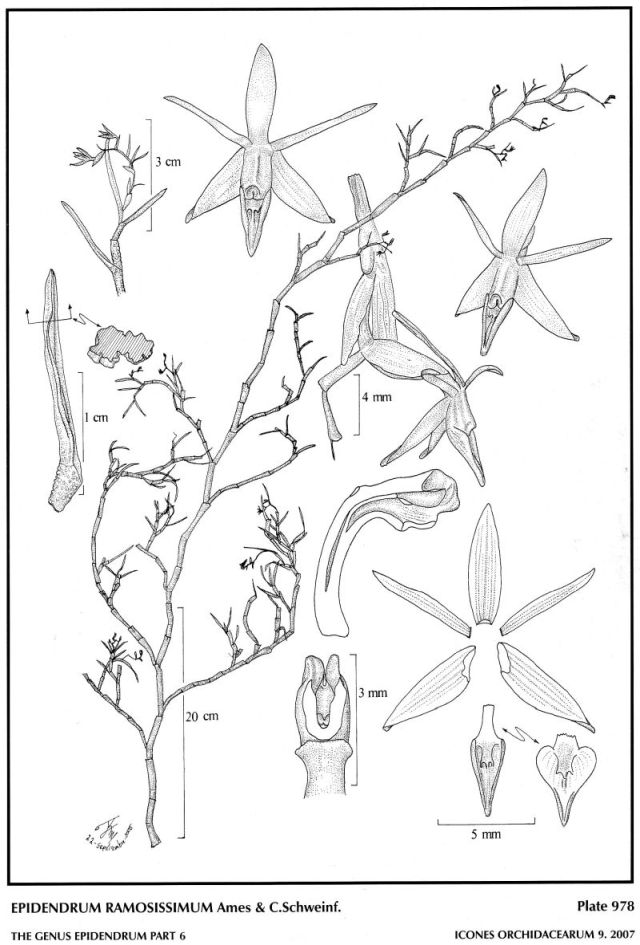

Epidendrum ramosissimum Ames & C.Schweinf. 1925 GROUP Ramosum SUBGROUP Rugosum
TYPE Drawing R Jimenez M and The AMO Herbaria Website



 EARLY
EARLY 
Common Name The Most Branched Epidendrum
Flower Size .6" [1.5 cm]
Found in Costa Rica on the lower Atlantic slope in rainforests at elevations of 500 to 1350 meters as a medium sized, warm to cool growing epiphyte with branching, cane-like, terete stems carrying 14 or more on the main stem, all along the stem, deciduous as the plant matures 3 to 7 on the branches, all along the apical 1/3'rd of the stem, linear to ligulate, acute to obtuse, terete, deeply channeled, main stem longer than the branch leaves that blooms in the fall till early winter on a terminal, distichous, peduncle short, rachis fractiflex, lax, simultaneously 1 to 4 flowered inflorescence with as long as the ovary, conduplicate, oblong, obtuse floral bracts and carrying resupinate, white to creamy green flowers.
"Epidendrum ramonianum belongs to the GROUP Ramosum which is characterized by the monopodial, branching stems, the distichous inflorescence, and the single callus, and the SUBGROUP Platystigma which has monopodial erect plants with a clear primary stem; branching occurs from the axil of the leaves, producing few, short, small-leaved branches, and these produce successive, short branches from a subapical internode, thus an old plant has numerous branches, these progressively made of fewer elements, and often lacking the juvenile, long leaves of the main stem at this stage the plant attains full flowering and often dies. The species can be recognized by its terete, strongly canaliculate, linear leaves, the floral bracts longer than the ovaries, 1 to 4 flowers, the sepals .26 to .3" [6.5 to 7.5 mm] long, narrowly lanceolate, and the lip tubular-involute in natural position, cordiform, acuminate, the base truncate, with a tridentate callus. It is similar to Epidendrum lancilabium Schltr., which also has terete leaves, but a shorter habit, and larger, purple-green flowers, the sepals .36 to .44# 9 to 11 mm] long, and a lanceolate lip. Epidendrum sanchoi Ames has a similar branching habit but flat leaves, smaller flowers, sepals .18 to .22" [4.5 to 5 mm] long, the lip triangular, cordate, ecallose, with 3, thickened veins on the disc. Epidendrum anoglossoides Ames & C.Schweinf. grows at higher elevations, at 2300 to 2800 meters altitude, has flat elliptic-lanceolate leaves, 3 to 10, larger, yellowish green flowers, sepals .28 to .36" [7 to 9 mm] long, and an arching, nutant inflorescence. Epidendrum elcimeyae Hágsater & Carda-Cruz also has lanceolate, flat leaves, yellowish green flowers, sepals .26 to .28" [6.5 to 7 mm] long and a triangular cordate lip." Hagsater 2007
Synonyms
References W3 Tropicos, Kew Monocot list , IPNI ; The Genus Epidendrum Ames 1936; Ceiba Vol 5 No 1 L O Williams 1956; Field Guide to the Orchids of Costa Rica and Panama Dressler 1993; Icones Orchidacearum 9 Plate 951 Hagsater 2007 see recognition section; Icones Orchidacearum 9 Plate 978 Hagsater 2007 drawing fide; Icones Orchidacearum 13 Plate 1381 Hagsater & Dodson 2010 See Recognition section;
--------------------------------------------------------------------------------------------------------------------------